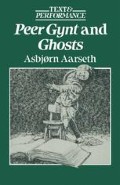Abstract
Rogaland Theatre, established in Stavanger in 1947, is one of the younger Norwegian theatres, and its resources are relatively limited. Yet this theatre managed in its 30th season to present a Peer Gynt performance which by its artistic energy and radical conception impressed critics and audience alike. The man behind this contribution to the 150th anniversary of Ibsen’s birth was Kjetil Bang-Hansen, manager and director. He had studied both stage direction and classical ballet partly in Oslo and partly in London, where he admired Jerome Robbins among others. He had developed an idea of theatrical language where the images of the literary text constitute the basic object of presentation, but where the vehicle is not limited to verbal art. Equally important is the physical appearance on the stage, the human body, its costume and mask, its movements and light and sound effects commanding the attention of the audience. This idea gives great liberty to the director and his team, especially when the text in question is a dramatic poem, originally not intended for stage presentation. Bang-Hansen has given an outline of his conception of Peer Gynt in a preface to the programme:
We regard Peer Gynt more as an inner drama than as a realistic picture of life. It is to us a poem where the figures are personifications of the qualities and instincts of a man. We present a process of ripening in a human being in need. It is therefore not necessarily a development in the physical sense, in age. The process Ibsen describes can be as long as a life, as short as a beat of the heart. Basically, what is involved is a mounting mental derangement, the fear of it and of extinction, and the question of surrender or go on fighting. The encounter with Solvejg at the end is therefore in our interpretation Peer’s first step towards his proper self. He understands now that the way to the self must go through the encounter with another human being. If he then is able to make use of the understanding he has achieved is really the main problem of the poem. Thus in principle the whole thing is not at its starting point until the moment we finish.
Preview
Unable to display preview. Download preview PDF.
Copyright information
© 1989 Asbjørn Aarseth
About this chapter
Cite this chapter
Aarseth, A. (1989). Peer Gynt at Rogaland Theatre 1978. In: Peer Gynt and Ghosts. Text and Performance. Palgrave, London. https://doi.org/10.1007/978-1-349-09204-8_11
Download citation
DOI: https://doi.org/10.1007/978-1-349-09204-8_11
Publisher Name: Palgrave, London
Print ISBN: 978-0-333-43274-7
Online ISBN: 978-1-349-09204-8
eBook Packages: Palgrave Literature & Performing Arts CollectionLiterature, Cultural and Media Studies (R0)

